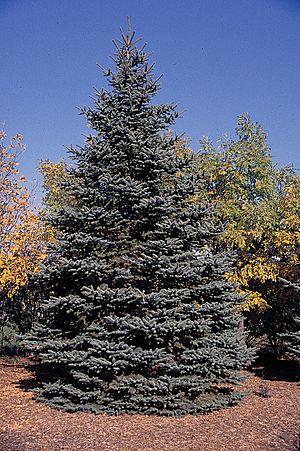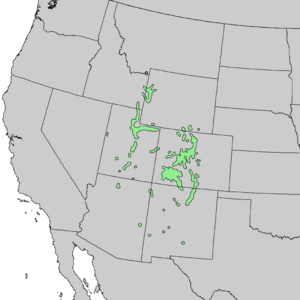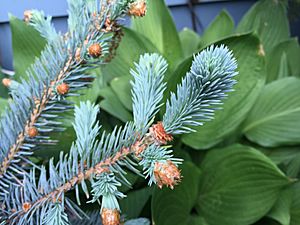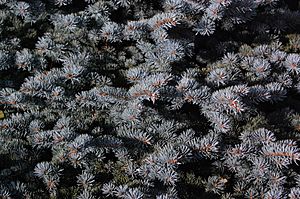Blue spruce facts for kids
Quick facts for kids Blue sprucePicea pungens |
|
|---|---|
 |
|
| Conservation status | |
| Scientific classification | |
| Genus: |
Picea
|
| Species: |
pungens
|
 |
|
The blue spruce (Picea pungens) is a type of spruce tree. It is also known by other names like green spruce, white spruce, Colorado spruce, or Colorado blue spruce. This tree naturally grows in North America, especially in places like New Mexico, Colorado, Utah, Wyoming, Alberta, and British Columbia. People also plant it in many other areas as a beautiful ornamental tree. The blue spruce is known for its blue-green needles and is a coniferous tree, meaning it produces cones.
Contents
What Does a Blue Spruce Look Like?
In the wild, blue spruce trees can grow to about 23 meters (75 feet) tall. However, when planted in parks and gardens, they usually stay smaller, around 15 meters (50 feet) tall and 5 meters (16 feet) wide. This tree is an evergreen conifer, which means it keeps its needles all year round. It has a tall, narrow shape with branches that grow out horizontally. The trunk has scaly grey bark, and its branches are yellowish-brown.
Its waxy, gray-green needles are about 3 centimeters (1.2 inches) long. They grow all around the shoots, which often curve upwards. The cones are pale brown and can be up to 10 centimeters (4 inches) long. Male cones grow all over the tree, while female cones are usually found at the very top. This helps the tree to cross-pollinate, meaning pollen from one part of the tree can reach another.
The scientific name pungens means "sharply pointed." This refers to the sharp tips of the needles. The blue spruce is also the official state tree of Colorado.
Growing Blue Spruce Trees
Blue spruce trees and their different types, called cultivars, are often planted in gardens and parks because they look nice. They are also grown for the Christmas tree industry, meaning many become Christmas trees during the holidays.
Common Problems for Blue Spruce
Like many trees, blue spruces can face issues with insects and diseases. Some tiny insects, like aphids, can cause galls (unusual growths) on the twigs. Other insects, like the spruce budworm, eat the buds and new shoots. Some even hollow out the needles.
Diseases can also affect the needles, making them turn yellow, spotted, or brown before they fall off. A disease called canker can cause branches to turn reddish-brown and die, with white resin appearing on the bark. However, blue spruces are generally quite strong.
How Blue Spruce Roots Grow
Young blue spruce trees have shallow roots, meaning they don't go very deep into the soil at first. Even though their roots are shallow, blue spruces can stand strong against powerful winds. Special care, like pruning the roots, can help them grow more roots and become even stronger, which is good for planting them in landscapes.
Popular Types of Blue Spruce
Many different types of blue spruce have been developed. These are called cultivars, and they often have unique features like different shapes or colors. Here are some popular ones:
- 'Glauca Globosa' – a shrub that grows about 1 to 1.5 meters (3 to 5 feet) tall.
- 'Fat Albert' – a compact, silver-blue tree that forms a perfect cone, growing up to 3 meters (10 feet) tall.
- 'Glauca Jean's Dilly' – a shrub that grows about 1 to 2 meters (3 to 6 feet) tall.
- 'Glauca Pendula' – a type with drooping branches that spreads about 2.5 meters (8 feet) wide and 1.2 meters (4 feet) tall.
- 'Hoopsii'
- 'Koster'
- 'Baby Blue Eyes'
- 'Baby Blue'
Uses of the Blue Spruce
Native American tribes, like the Navajo and Keres, have traditionally used the blue spruce. They used it as a medicinal plant and in ceremonies. Twigs were sometimes given as gifts to bring good luck.
In traditional medicine, a liquid made from the needles was used to help with colds and upset stomachs. This liquid was also used on the skin to ease rheumatic pains. Early people also used the wood from these trees for building.
Where Blue Spruce Trees Grow Best
Blue spruce trees usually grow in areas with gentle slopes and well-watered soil. They are often found near streams and on cooler, north-facing slopes. The soil they grow in is often rich and fertile. Blue spruce is considered a "pioneer" tree in moist soils in places like Utah, meaning it's one of the first trees to grow in new or disturbed areas.
Climate for Blue Spruce
Blue spruce trees prefer cool and humid climates. Most of the rain they get happens during the summer. In Colorado and the Southwest, where they are common, the average yearly temperature is about 3.9 to 6.1 degrees Celsius (39 to 43 degrees Fahrenheit). Winters can be quite cold, and summers are mild.
These trees get about 460 to 610 millimeters (18 to 24 inches) of rain each year. Most of this rain falls during the growing season. Blue spruce trees like plenty of moisture, but they are also quite tough. They can handle droughts better than many other spruce trees. They can also survive very cold temperatures, even as low as -40 degrees Celsius (-40 degrees Fahrenheit)! They are also more resistant to strong sunlight and frost damage compared to other trees in their habitat.
Gallery
Images for kids
See also
 In Spanish: Pícea de Colorado para niños
In Spanish: Pícea de Colorado para niños













